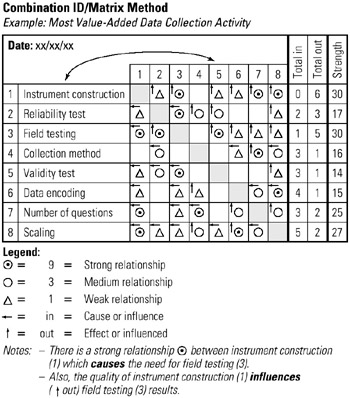Tool 141: Prioritization Matrix-Combination
| AKA | N/A |
| Classification | Evaluating/Selecting (ES) |
Tool description
First introudced by T. L. Saaty (1988), prioritization matrices are used to prioritize among projects, issues, or options on the basis of team-established, weighted criteria. Three variations of matrix construction are used: (A) the full analytical criteria method, (B) the consensus criteria method, and (C) the combination interrelationship digraph/matrix method. Variation (C), the combination method, is used when strongly related options must be reduced to one or two.
Typical application
-
To apply team consensus criteria to select and decide on further action.
-
To prioritize among activities, issues, or options based on weighted criteria.
-
To select and prioritize recommended change options.
-
To allocate limited resoures to the most important option.
Problem-solving phase
| → | Select and define problem or opportunity |
| Identify and analyze causes or potential change | |
| Develop and plan possible solutions or change | |
| → | Implement and evaluate solution or change |
| Measure and report solution or change results | |
| Recognize and reward team efforts |
Typically used by
| Research/statistics | |
| Creativity/innovation | |
| 5 | Engineering |
| 1 | Project management |
| 3 | Manufacturing |
| Marketing/sales | |
| Administration/documentation | |
| 4 | Servicing/support |
| Customer/quality metrics | |
| 2 | Change management |
before
-
Tree Diagram
-
Consensus Decision Making
-
Task Analysis
-
Information Needs Analysis
-
Nominal Group Technique (NGT)
after
-
Action Plan
-
Objectives matrix (OMAX)
-
Responsibility Matrix
-
Process Mapping
-
Resource Requirements Matrix
Notes and key points
-
The combination I.D./data matrix method
This method is easy to complete; however, great care must be given when relationship or cause and effect ratings are determined. It may be necessary to recheck the entire final matrix in order to verify consistency of ratings.
-
Refer to Thomas L. Saaty's book Decision Making for Leaders, University of Pittsburgh (1988) for additional information on prioritization processes.
Step-by-step procedure
-
STEP 1 The team decides what project, issue, or option needs to be prioritized.
-
STEP 2 Select a particular prioritization matrix method to be constructed. There are three alternatives:
-
Full analytical criteria method
-
consensus criteria method
-
Combination ID/matrix method
-
-
STEP 3 The team agrees to prioritize the best data collection appraoch. See example Combination ID/Matrix Method Matrix.
-
STEP 4 Next, the team determines the strength of the relationship, if any, by comparing each element with all other elements, as shown in the example matrix.
-
STEP 5 Comlete the Total in, Total out, and Strength columns. This will complete the matrix.
-
STEP 6 Recheck all symbols and calculations and date the matrix.
Example of tool application
Example: Most Value-Added Data Collection Activity

EAN: 2147483647
Pages: 326
- Step 3.2 Use PuTTY / plink as a Command Line Replacement for telnet / rlogin
- Step 3.3 Use WinSCP as a Graphical Replacement for FTP and RCP
- Step 4.6 How to use PuTTY Passphrase Agents
- Step 5.2 Troubleshooting Common OpenSSH Errors/Problems
- Step 6.2 Using Port Forwarding Within PuTTY to Read Your E-mail Securely